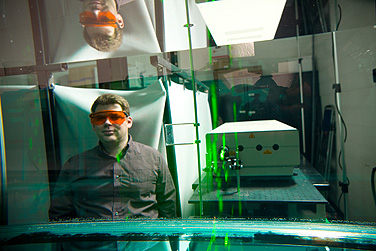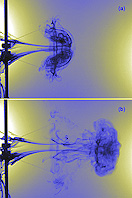News
Hummingbird flight inspires research

Matthew Ringuette and his colleagues are conducting experiments on rectangular flapping “wings” in a water tank. When tiny reflective particles placed in the water are illuminated by laser light, the researchers will be able to digitally record and measure the motion of the particles, revealing the fundamental nature of the vortex. Photo: DOUGLAS LEVERE
The secret to the flight of the hummingbird and other tiny birds and insects lies in the looping, swirling flow of air, called a vortex, that their flapping wings create.
These aerodynamically unconventional flows are the inspiration behind new research by a UB faculty member who hopes to understand the nature of the three-dimensional, vortex-formation process so it can be used in intelligence applications.
The research is motivated by the need to gather real-time intelligence in particularly challenging environments, such as remote caves and tunnels or complex building corridors in cities—none of which can be penetrated easily by conventional, unmanned aircraft or spy satellites. One solution being explored is the design of tiny, flying surveillance devices called micro-air vehicles that are bio-inspired, based on lessons drawn from the behavior of insects and birds.
“In surveillance applications, these small, autonomous or remote-controlled vehicles would be ideal because they would be able to penetrate these complex kinds of terrain and gather first-hand, real-time intelligence,” says Matthew Ringuette, assistant professor in the Department of Mechanical and Aerospace Engineering, School of Engineering and Applied Sciences. He recently received an award to do the research from the Young Investigator Research Program in the Air Force Office of Scientific Research.
But developing flying devices on the scale of just a few inches requires a much greater understanding of the propulsion systems of tiny birds and insects.
“When you get down to such small sizes and slow speeds, conventional aerodynamics no longer apply,” Ringuette explains.
Instead of the streamlined flow that occurs when air flows over the wing of a jet, for example, fluid dynamics at the much-smaller scale of hummingbird wings is characterized by swirling flow and vortex formation, similar to that created by canoe paddles as they are pushed through the water.
“Animals, such as insects and birds, take advantage of this vortex formation to achieve flight and outstanding maneuverability,” he says.
Ringuette’s research is designed to discover how the vortex growth and development scales with wing size, motion and shape so that the wing of a micro-air vehicle can be optimized for maximum, propulsive force and efficiency. He notes that this work is fundamental to three-dimensional vortex formation in general, which occurs in a variety of settings, from cardiovascular flows to wind-energy applications.
He plans to conduct experiments using a robotic, flapping-wing model that will propel itself through a 13x4x3-foot water tank in his Vortex Dynamics and Bio-Inspired Propulsion Lab. In water, these flapping-wing models can produce at larger scales vortex formation similar to that exhibited by birds and insects. He will make quantitative measurements of wing-flow velocity and the forces at work during propulsion, supplemented by dye visualization, to obtain a picture of the three-dimensional flow.
Ringuette is one of 38 young scientists nationwide to receive the Young Investigator Research Program award, which is designed to foster creative research in science and engineering, enhance early career development of outstanding young researchers and increase opportunities for young researchers to recognize the Air Force mission and related challenges in science and engineering.


Reader Comments